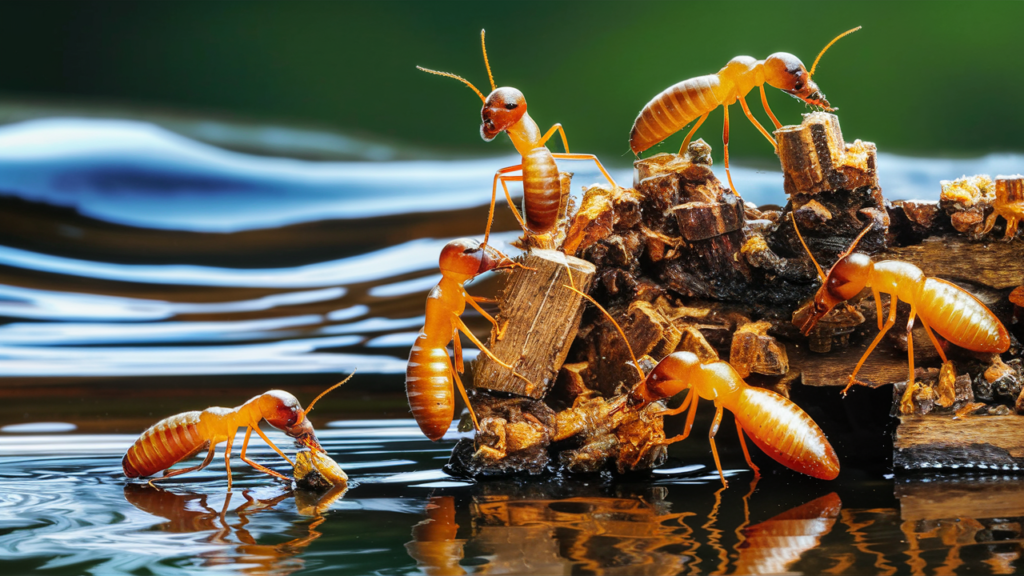
Imagine you’re enjoying a serene evening by the lake near your home, the gentle lapping of the water melding with the quiet of dusk. Suddenly, your gaze falls on something unexpected along the water’s edge: a group of termites seemingly unbothered by the proximity to water. This sight might prompt a question that’s as intriguing as it is relevant to homeowners and environmental enthusiasts: Can termites swim?
Termites are often associated with silent destruction, lurking in the hidden corners of homes and devouring wood with relentless determination. Yet, the scene by the lake offers a glimpse into a lesser-known aspect of these creatures, leading us to explore their destructive capabilities and their surprising relationship with water. This article delves into the fascinating world of termites, shedding light on their behavior around water and providing insights that could help protect your home from their unwelcome advances.
Understanding Termites
Before diving into termites’ aquatic abilities, let’s first understand who these creatures are. Termites are social insects, divided into various types such as subterranean, drywood, and damp wood, each with its unique habitat preferences. These insects are often vilified for their role in causing property damage, yet they play a crucial part in our ecosystem by breaking down cellulose, thus recycling dead plant material.
Their role, however, becomes a point of contention when it intersects with human habitation. Termites’ ability to consume wood can lead to significant structural damage, making them unwelcome guests in our homes. Understanding their behavior, habitat preferences, and survival strategies is essential for homeowners looking to safeguard their properties.
Can Termites Swim? The Surprising Truth
So, can termites swim? The answer is complex. While termites are not swimmers in the traditional sense, they have developed remarkable strategies to survive in moist environments and even during floods. Termites cannot swim like fish or aquatic mammals, but certain species can survive underwater for up to 24 hours by entering a state of reduced metabolic activity.
This ability to withstand temporary submersion is crucial for species like the subterranean termite, which might encounter water as they tunnel through the soil in search of food. However, it’s important to debunk a common myth: termites do not seek water for the sake of swimming. Instead, their relationship with water is more about survival and the continuation of their species in damp environments.
How Termites Deal with Water
Understanding how termites deal with water reveals the complexity of these creatures. Termites use a combination of physical adaptations and social behaviors to survive in wet conditions. For instance, subterranean termites build waterproof tunnels made of mud, saliva, and feces, which protect them from direct contact with water. These tunnels allow them to navigate to food sources without drowning or getting swept away by water.
Moreover, termite colonies respond to flooding by moving to higher ground or constructing vertical tunnels to escape rising water levels. Their social structure, with workers, soldiers, and a queen, ensures the colony’s survival, demonstrating their resilience and adaptability to environmental challenges, including water.
Preventing Termite Water Intrusion
Given termites’ ability to endure in moist environments, homeowners must take proactive measures to minimize the risk of termite invasion. Preventing water intrusion and controlling moisture are key strategies. Ensure that your home’s foundation is well-drained, fix leaks promptly, and use dehumidifiers in damp areas of your house. Regularly inspect your property for signs of termite activity, especially in wet areas around pipes, faucets, and the roof.
Landscaping practices also play a role in termite prevention. Avoid directing water towards your home’s foundation with sloped landscaping, and keep gutters clean to prevent water buildup. Creating an environment that’s less attractive to termites can significantly reduce the likelihood of an infestation.
Case Studies: Termites and Water
Real-life case studies underscore the adaptability of termites to water-related challenges. For instance, following a flood in a coastal town, homeowners were surprised to find termite colonies thriving in their water-logged homes, having constructed elaborate networks of mud tubes that traversed flooded areas. Such scenarios highlight the importance of understanding termite behavior to combat their resilience effectively.
FAQs: Termites and Their Relationship with Water
To further demystify termites and their relationship with water, here are answers to some frequently asked questions:
- Do termites drown in water? Termites can drown if submerged for extended periods, but certain species have adaptations that allow them to survive temporary submersion.
- Can termites damage homes more after flooding? Flooding can exacerbate termite damage as the insects take advantage of weakened structures and increased moisture levels.
- How can I protect my home from termites after a flood? Promptly address water damage, reduce moisture levels, and inspect your property for termite activity to prevent infestation.
Conclusion: Protecting Your Home from Termites
While termites cannot swim in the conventional sense, their ability to navigate and survive in moist environments poses unique challenges for homeowners. Understanding these insects’ relationship with water is crucial in developing effective strategies to protect your property. By taking proactive steps to control moisture and being vigilant about termite prevention, you can safeguard your home against these persistent pests.
Remember, the battle against termites is not just about eliminating them but about creating a living environment that’s less inviting to them. Consulting with pest control professionals can provide tailored solutions to keep your home termite-free. Together, we can ensure that our homes remain safe sanctuaries, undisturbed by the hidden dangers of termites.
